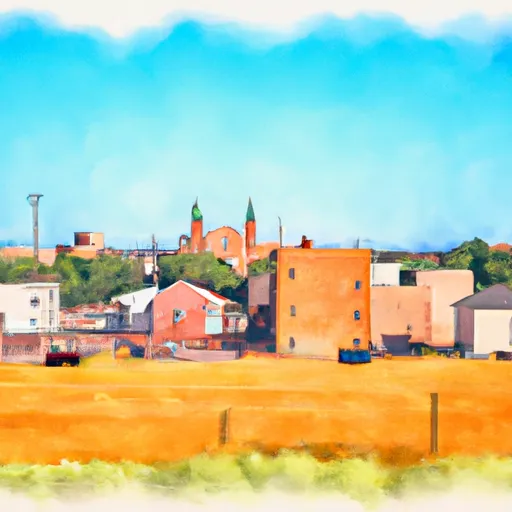-
 Snoflo Premium
Snoflo Premium
Get unlimited access to all our content
With no Ad interruptions! - Start Your Free Trial Login with existing account
Summerfield
Eden Index
Climate
8.1
•
Recreation
0.9
•
Community
•
Safeguard
3.5/10

Summerfield, Kansas is a picturesque town located in the northeastern part of the state. The town experiences a humid continental climate, characterized by hot and humid summers, and cold winters. Summers are generally warm, with temperatures ranging from the high 70s to the low 90s Fahrenheit. Winters, on the other hand, are cold, with temperatures dropping below freezing and occasional snowfall.
Summerfield is blessed with abundant hydrology constituents, as it is surrounded by several bodies of water. The town lies close to the Big Blue River, which offers opportunities for fishing, canoeing, and boating. Additionally, Summerfield is situated near several lakes and reservoirs, including Tuttle Creek Lake and Milford Lake, where visitors can engage in water sports such as swimming and water skiing.
For outdoor enthusiasts, Summerfield provides a range of recreational opportunities. The town is surrounded by rolling hills and picturesque landscapes, making it an ideal destination for hiking and camping. The nearby Konza Prairie offers breathtaking views and opportunities for wildlife observation and bird-watching. Visitors can also explore the various trails and parks in and around Summerfield, such as the Tuttle Creek State Park, which offers activities like horseback riding and mountain biking. With its favorable climate and abundant natural resources, Summerfield is a paradise for those seeking an outdoor adventure.
What is the Eden Index?
The Snoflo Eden Index serves as a comprehensive rating system for regions, evaluating their desirability through a holistic assessment of climate health, outdoor recreation opportunities, and natural disaster risk, acknowledging the profound impact of these factors on livability and well-being.
Climate Health Indicator (CHI): 8.1
Summerfield receives approximately
825mm of rain per year,
with humidity levels near 84%
and air temperatures averaging around
12°C.
Summerfield has a plant hardyness factor of
5, meaning
plants and agriculture in this region thrive during a short period during spring and early summer. Most
plants will die off during the colder winter months.
By considering the ideal temperature range, reliable water supplies, clean air, and stable seasonal rain or snowpacks, the Climate Health Indicator (CHI) underscores the significance of a healthy climate as the foundation for quality living.
A healthy climate is paramount for ensuring a high quality of life and livability in a region, fostering both physical well-being and environmental harmony. This can be characterized by ideal temperatures, reliable access to water supplies, clean air, and consistent seasonal rain or snowpacks.
Weather Forecast
Streamflow Conditions
Big Blue
Area Rivers
Big Blue
Snowpack Depths
Big Blue
Reservoir Storage Capacity
Big Blue
Groundwater Levels
Recreational Opportunity Index (ROI): 0.9
The Recreational Opportunity Index (ROI) recognizes the value of outdoor recreational options, such as parks, hiking trails, camping sites, and fishing spots, while acknowledging that climate plays a pivotal role in ensuring the comfort and consistency of these experiences.
Access to outdoor recreational opportunities, encompassing activities such as parks, hiking, camping, and fishing, is crucial for overall well-being, and the climate plays a pivotal role in enabling and enhancing these experiences, ensuring that individuals can engage in nature-based activities comfortably and consistently.
Camping Areas
| Campground | Campsites | Reservations | Toilets | Showers | Elevation |
|---|---|---|---|---|---|
| Louisville Lakes State Rec Area | 300 | 1,032 ft | |||
| Burchard Lake State Wildlife Area | 10 | 1,336 ft | |||
| Weeping Water | 25 | 1,081 ft | |||
| Centralia Lake | None | 1,285 ft | |||
| Oregon Trail RV Park | 16 | 1,182 ft | |||
| Eugene T. Mahoney State Park | 150 | 1,167 ft |
Nearby Fishing
Catastrophe Safeguard Index (CSI):
The Catastrophe Safeguard Index (CSI) recognizes that natural disaster risk, encompassing floods, fires, hurricanes, and tornadoes, can drastically affect safety and the overall appeal of an area.
The level of natural disaster risk in a region significantly affects safety and the overall livability, with climate change amplifying these risks by potentially increasing the frequency and intensity of events like floods, fires, hurricanes, and tornadoes, thereby posing substantial challenges to community resilience and well-being.
Community Resilience Indicator (CRI):
The Community Resilience Indicator (CRI) recognizes that education, healthcare, and socioeconomics are crucial to the well-being of a region. The CRI acknowledges the profound impact of these elements on residents' overall quality of life. By evaluating educational resources, healthcare accessibility, and economic inclusivity, the index captures the essential aspects that contribute to a thriving community, fostering resident satisfaction, equity, and social cohesion.

